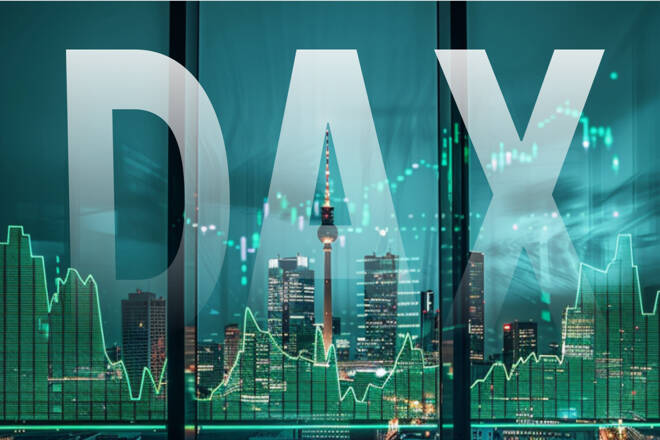Advertisement
Advertisement
Dax Index News: DAX Forecast Slips Below 24,100 Amid Hawkish Fed and Trade Fears
By:
Key Points:
- DAX fellfor a fourth straight session on July 15, closing at 24,060 as US inflation dims Fed rate cut hopes.
- Hot US CPI data and tariff risks weigh on sentiment, overshadowing upbeat German ZEW data.
- DAX outlook hinges on US-EU trade talks, Fed commentary, and upcoming US producer price figures.
DAX Extends Losses Streak to Four Sessions as US Inflation Heats Up
Hotter US inflation numbers revealed the effects of tariffs, signaling a less dovish Fed stance. The DAX fell 0.42% on Tuesday, July 15, following Monday’s 0.82% loss, closing at 24,060. Notably, the DAX extended its losing streak to four sessions.
US-EU trade deal uncertainties also weighed on sentiment as President Trump’s August 1 deadline looms. Failure to reach a trade agreement could expose the EU to 30% US tariffs on goods bound for the US.
Trade uncertainty and reduced optimism about a Fed rate cut overshadowed upbeat German data. The ZEW Economic Sentiment Index rose to 52.7 in July, up from 47.5 in June.
ZEW President Prof. Achim Wambach, PhD, remarked:
“Hopes for a speedy resolution of the US-EU tariff dispute and potential economic stimulus from the German government’s planned emergency investment program appear to dominate sentiment.”
Sector Snapshot: Bank Stocks Stumble While Autos Shine
Concerns about US tariffs impacting the Eurozone economy weighed on banking stocks. Commerzbank led the losses, sliding 2.91%, with Deutsche Bank falling 0.53%.
In contrast, auto stocks rallied. BMW climbed 1.92%, while Mercedes-Benz Group advanced 1.49%. Porsche and Volkswagen also posted gains.
Wall Street Mixed as US Inflation and Trade Developments Trigger Market Divergence
US markets had a mixed session on July 15. Hotter US inflation weighed on sentiment while easing US restrictions on chip exports to China drove demand for AI chipmaker stocks. The Dow and the S&P 500 dropped 0.98% and 0.40%, respectively, while the Nasdaq Composite Index rose 0.18%. Notably, NVIDIA and AMD surged 4.04% and 6.41%, respectively.
Reports of the US Commerce Department reviewing licenses to export MI308 chips to China followed news that NVIDIA plans to resume H20 chip exports to China. The news lifted demand for US tech-related stocks.
US Producer Prices, the Fed, and Trade Talks in Focus
Later in the July 16 session, US producer price data is likely to influence sentiment. Economists forecast producer prices to rise 2.5% year-on-year (YoY) in June, down from 2.6% in May.
As a leading CPI indicator, softer prices may signal cooling inflationary pressures, potentially reviving bets on Fed rate cuts. A more dovish Fed policy stance would likely boost demand for risk assets such as the DAX. Conversely, higher prices may sink expectations of a Fed rate cut and weigh on sentiment.
Beyond the data, investors should closely track Fed commentary and trade developments. Fed speakers’ views on inflation and interest rates will fuel speculation about Fed policy moves. However, trade headlines are likely to outweigh central bank guidance.
Outlook: Key Catalysts for the DAX
The DAX’s near-term outlook depends on US-EU trade talks, US inflation, and central bank signals.
- Bullish Case: A US-EU trade deal, softer producer prices, and dovish central bank rhetoric could send the DAX toward the record high of 24,639.
- Bearish Case: Stalled US-EU trade talks, rising producer prices, or hawkish central bank cues may push the DAX below 24,000, potentially exposing the 50-day EMA.
At the time of writing on July 16, the DAX futures dropped 58 points, while the Nasdaq 100 was down 37 points. Futures markets signaled a cautious start to the mid-week session as investors consider US-EU trade talks and the Fed’s rate path.
DAX Technicals
Despite a four-day losing streak, the DAX remains above the 50-day and 200-day Exponential Moving Averages (EMA), indicating a bullish bias.
- Upside Target: A breakout above the July 10 record high of 24,639 could pave the way to 24,750. A sustained move through 24,750 may bring 25,000 into play.
- Downside risk: A break below 24,000 may expose the 50-day EMA and potentially the 23,500 level.
The 14-day Relative Strength Index (RSI), at 53.28, suggests the DAX may revisit 24,639 before entering overbought territory (RSI > 70).
DAX Outlook: US-EU Trade News, US Inflation, and Central Bank Commentary
Traders should closely track US-EU trade talks, US inflation data, and central bank commentary. Failed talks and rising tensions would likely pressure the DAX. Conversely, a trade deal could drive the DAX to record highs. Trade headlines will have greater weight than central bank guidance.
Explore our exclusive forecasts to assess whether improving trade sentiment could lift the DAX to new highs. Refer to our latest forecasts and macro insights here for further analysis, and consult our economic calendar.
About the Author
Bob Masonauthor
With over 28 years of experience in the financial industry, Bob has worked with various global rating agencies and multinational banks. Currently he is covering currencies, commodities, alternative asset classes and global equities, focusing mostly on European and Asian markets.
Advertisement
